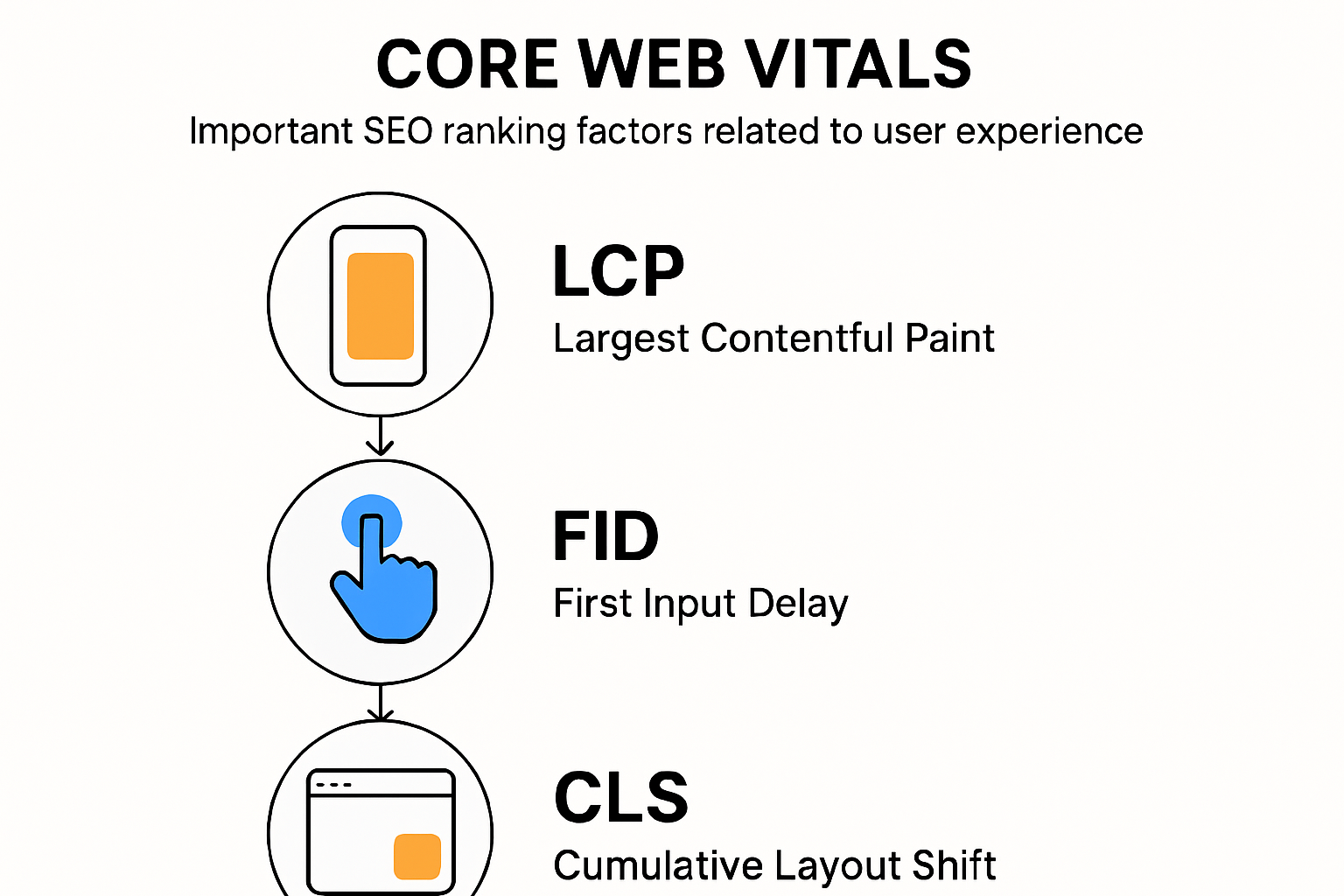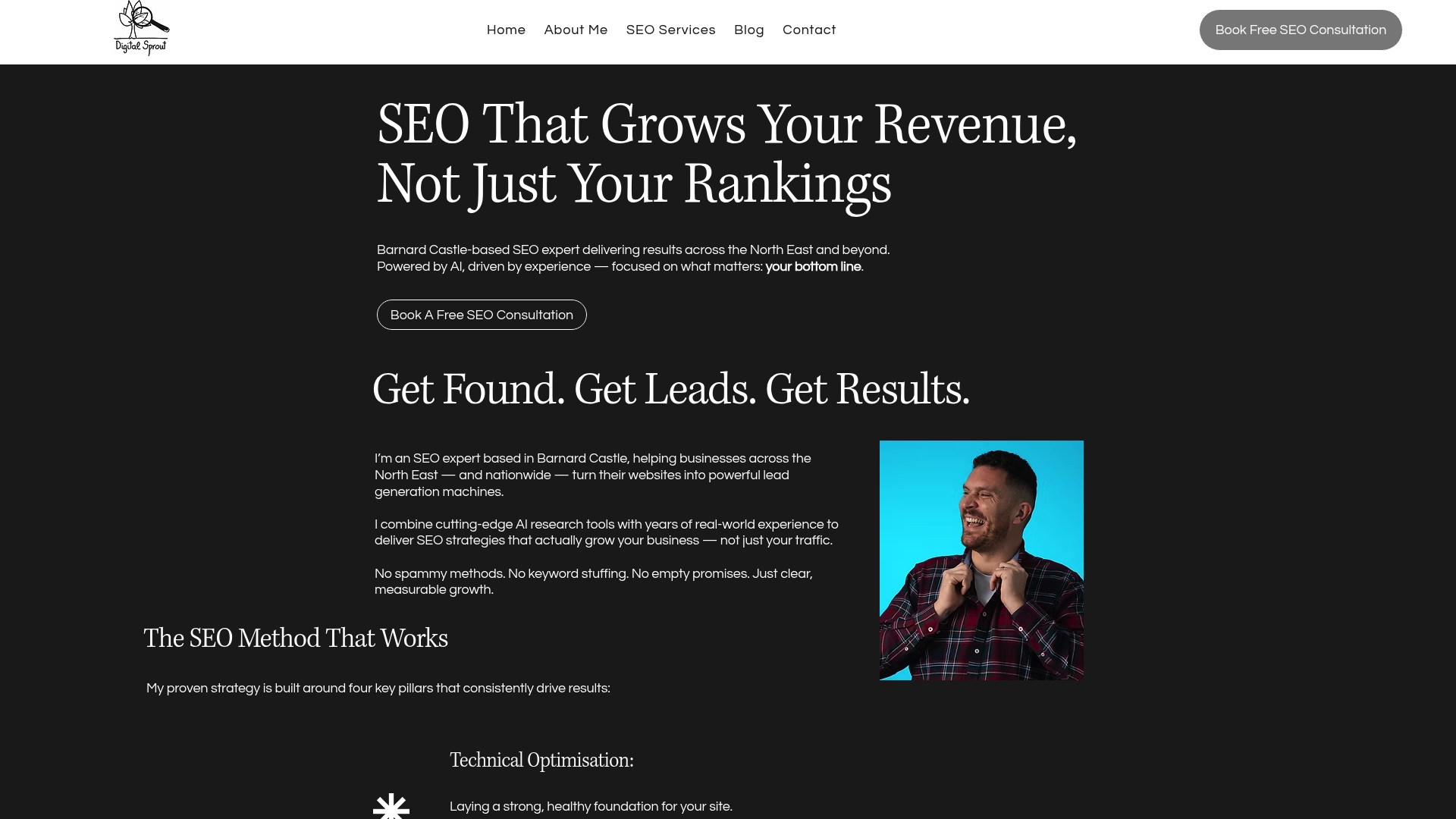SEO Ranking Factors: 2025 Guide
- Mike Dodgson
- May 20
- 9 min read
Updated: Jun 22
Google’s search algorithm is more complex than you might think. With over 200 factors influencing your search ranking, it’s easy to feel overwhelmed. But here’s the twist: mastering these elements can significantly boost your online presence. The key lies in understanding that it’s not just about keywords or backlinks; it’s about crafting quality content that answers your audience’s needs while ensuring a seamless user experience.
Table of Contents
Quick Summary
How Google Search Algorithm Works
Google’s search algorithm is a sophisticated system designed to deliver the most relevant and high-quality results to users within milliseconds. Understanding its intricate workings provides crucial insights for businesses and content creators aiming to improve their online visibility.
The Three Fundamental Stages of Google Search
The search process operates through three critical stages that ensure users receive the most accurate information possible. Google’s official documentation reveals these stages as crawling, indexing, and serving.
Crawling is the initial phase where automated bots, known as web crawlers or spiders, systematically browse the internet, discovering and collecting information from web pages. These digital explorers follow links between pages, mapping the vast interconnected network of online content. During this process, they examine new websites, updated content, and changes to existing pages.
Indexing represents the next crucial stage, where Google analyzes and organizes the collected information. The search engine comprehensively examines page content, keywords, images, video files, and overall website structure. Advanced machine learning algorithms categorize and store this information in an enormous, lightning-fast database that can be quickly retrieved when users perform searches.
Ranking Factors and Content Evaluation

Key ranking considerations include:
- Content Relevance
: How closely the content matches user intent
- Page Quality
: Depth of information, expertise, and comprehensiveness
- User Experience
: Website loading speed, mobile-friendliness, and navigation
- Backlink Profile
: Authority and quality of websites linking to the content
Interestingly, Google’s Search guidelines emphasize that paying for crawling or ranking does not influence search position. This means organic quality remains the primary determinant of search visibility.
The Evolution of Search Intelligence
Google continuously refines its algorithm, incorporating advanced machine learning and artificial intelligence to improve search results. The RankBrain system, for instance, uses machine learning to understand search query context and user intent more accurately than ever before.
Modern search algorithms can now interpret nuanced language, understand semantic relationships between words, and even predict user intentions. This means content must be not just keyword-optimized, but genuinely informative and aligned with user needs.
For businesses and content creators, this underscores the importance of creating high-quality, user-focused content that genuinely addresses audience questions and provides valuable insights. The days of simple keyword stuffing are long gone, replaced by a more sophisticated approach that prioritizes meaningful, comprehensive information.
Ultimately, Google’s search algorithm represents a remarkable technological achievement - a system capable of organizing and presenting the world’s information with unprecedented speed, accuracy, and relevance.
Top Technical Website Factors
Technical website factors represent the critical backend elements that significantly impact search engine rankings and user experience. While content remains king, the technical infrastructure of a website determines how effectively search engines can crawl, understand, and rank your digital presence.
Core Web Vitals and Performance Optimization
Google’s official guidelines emphasize three primary performance metrics that directly influence search rankings: Largest Contentful Paint (LCP), First Input Delay (FID), and Cumulative Layout Shift (CLS). These Core Web Vitals measure loading speed, interactivity, and visual stability respectively.
Website speed has become paramount in technical SEO. Even a one-second delay can dramatically reduce user engagement and conversion rates. Research from Google indicates that 53% of mobile users abandon sites that take longer than three seconds to load. This makes optimizing page speed a critical technical SEO factor.
Key performance optimization strategies include:
Minimizing server response times
Compressing images and multimedia content
Leveraging browser caching
Implementing content delivery networks (CDNs)
Reducing unnecessary JavaScript and CSS
Structured Data and Technical Markup
Entity-based SEO has transformed how search engines interpret website content. Implementing structured schema markup provides search engines with explicit context about your website’s content, enabling more sophisticated understanding and potentially enhanced search result displays.
Schema markup allows websites to communicate detailed information directly to search engines, covering everything from business details and product specifications to event information and customer reviews. Schema.org provides comprehensive guidelines for implementing these technical annotations.
Critical structured data considerations include:
Using appropriate JSON-LD format
Implementing precise, relevant schema types
Ensuring markup accuracy and completeness
Regularly validating structured data implementations
Technical Architecture and Crawlability
Website architecture plays a fundamental role in search engine optimization. Google’s documentation recommends creating a logical, hierarchical structure that enables efficient crawling and indexing.
Key technical architecture factors include:
Clean, descriptive URL structures
Proper implementation of canonical tags
Mobile-first responsive design
Secure HTTPS protocol
XML sitemap optimization
Intelligent internal linking strategies
International websites must also implement
hreflang tagsto indicate language and regional targeting, helping search engines serve the most appropriate content to users in different geographical locations.
Ultimately, technical website optimization is not about gaming search algorithms but creating a seamless, accessible, and high-performing digital experience. By focusing on performance, structured communication, and intelligent architecture, websites can significantly enhance their search visibility and user engagement.
Content Quality and Relevance Signals
In the ever-evolving landscape of search engine optimization, content quality and relevance have emerged as the most critical determinants of search ranking success. Google’s sophisticated algorithms now prioritize comprehensive, user-focused content that genuinely addresses searcher intent over traditional optimization techniques.
Depth and Comprehensiveness of Content
Backlinko’s comprehensive research reveals that content depth significantly impacts search rankings. The average top-ranking page on Google’s first page contains approximately 1,447 words, demonstrating that in-depth, thorough content consistently outperforms superficial treatments of a topic.
Comprehensive content goes beyond mere word count. It requires:

Thorough exploration of the subject matter
Addressing multiple angles and perspectives
Providing actionable, detailed insights
Anticipating and answering potential user questions
Search engines use advanced natural language processing to evaluate content comprehensiveness, assessing how thoroughly a piece addresses a given topic. This means content must offer genuine value, presenting information in a clear, structured, and meaningful manner.
Relevance and User Intent Alignment
Google’s Search Quality Evaluator Guidelines emphasize the critical importance of understanding and matching user intent. Modern search algorithms can distinguish between different types of search intentions: informational, navigational, transactional, and investigational.
Successful content must precisely align with these intent categories. For instance, a user searching for “how to fix a leaking tap” requires a step-by-step instructional guide, while someone searching “best plumbing services” needs comparative information and recommendations.
Key signals of content relevance include:
Direct addressing of user search query
Clear, logical content structure
Use of semantically related keywords
Inclusion of expert insights and authoritative information
Expertise, Authoritativeness, and Trustworthiness
Google’s E-A-T (Expertise, Authoritativeness, Trustworthiness) framework has become a cornerstone of content evaluation. Search Engine Journal highlights that content must demonstrate genuine expertise and credibility in its subject area.
This means:
Clear author credentials
Citations from reputable sources
Evidence of deep subject matter knowledge
Transparent, fact-based content creation
Regular content updates
Particularly in sensitive domains like health, finance, and legal information, demonstrating expertise is crucial. Websites must showcase clear qualifications, professional backgrounds, and verifiable credentials to build trust with both users and search algorithms.
Interestingly, digital marketing research indicates that content quality now comprises approximately 23% of ranking factors, significantly outweighing traditional elements like backlinks.
Ultimately, creating high-quality, relevant content is about understanding and serving user needs. It’s a holistic approach that combines deep subject knowledge, clear communication, and a genuine commitment to providing valuable, trustworthy information.
Building Authority with Backlinks
Backlinks remain a critical component of search engine optimization, serving as digital endorsements that signal a website’s credibility and relevance. In the complex ecosystem of SEO, high-quality backlinks function as votes of confidence from one website to another, directly influencing search engine rankings and overall digital authority.

The Quantitative Impact of Backlink Quality
Ahrefs’ comprehensive research reveals a startling statistic: 91% of online content receives zero organic traffic from Google, primarily due to insufficient quality backlinks. This underscores the critical importance of strategic link building in achieving meaningful search visibility.
Not all backlinks are created equal. Search engines prioritize links from:
Authoritative and relevant websites
Domains with high domain authority
Websites within similar industry niches
Platforms with established credibility
The quality of backlinks matters exponentially more than quantity. A single link from a renowned industry publication can be significantly more valuable than dozens of links from low-quality, irrelevant websites.
Strategic Link Acquisition Techniques
Moz’s link building guide emphasizes creating linkable assets - content so valuable that other websites naturally want to reference and link to it. These might include:
Original research and industry studies
Comprehensive guides
Interactive tools and calculators
Infographics with unique insights
Expert interviews and thought leadership content
Outreach remains a crucial component of link building. This involves:
Identifying relevant websites in your industry
Creating personalized communication
Demonstrating clear value proposition
Building genuine professional relationships
Evaluating and Managing Backlink Profiles
Search Engine Journal recommends regular backlink profile audits to maintain a healthy link ecosystem. This involves:
Identifying and removing toxic or spammy links
Monitoring link diversity
Tracking domain authority of linking websites
Ensuring natural link growth patterns
Interestingly, websites with consistent link growth demonstrate 2.3x higher domain authority improvement compared to those without active link-building strategies. This translates into enhanced search rankings, increased trust signals, and improved organic traffic potential.
Emergent link-building strategies in 2025 focus on creating genuine value and fostering authentic digital relationships. The era of manipulative link exchanges has been replaced by a more nuanced approach that prioritizes meaningful content and professional networking.

Ultimately, building authority through backlinks is about creating exceptional content that naturally attracts high-quality references. It’s a long-term strategy that requires patience, consistent effort, and a commitment to delivering genuine value in your digital ecosystem.
User Experience Impact on SEO
User experience (UX) has emerged as a pivotal factor in search engine optimization, transforming how websites approach digital design and functionality. Modern search algorithms increasingly prioritize websites that deliver seamless, intuitive, and engaging user interactions.
Core Web Vitals and Performance Metrics
Google’s official documentation defines Core Web Vitals as the critical performance indicators that directly influence search rankings. These metrics include Largest Contentful Paint (LCP), First Input Delay (FID), and Cumulative Layout Shift (CLS), which collectively measure loading speed, interactivity, and visual stability.Research from Web Landscape reveals that 76% of users will abandon websites with poor design or slow performance. This stark statistic underscores the critical relationship between user experience and digital success.
Key performance optimization strategies include:
Minimizing page load times
Reducing server response duration
Optimizing image and multimedia content
Implementing efficient caching mechanisms
Streamlining JavaScript and CSS
Mobile Responsiveness and Accessibility
With over 60% of Google searches conducted on mobile devices, mobile-friendliness has become a non-negotiable aspect of SEO strategy. Websites must provide a consistent, high-quality experience across various screen sizes and devices.
Effective mobile optimization involves:
Responsive design that adapts to different screen sizes
Touch-friendly navigation elements
Readable font sizes
Simplified menu structures
Fast-loading mobile pages
Avoiding intrusive pop-ups
Accessibility is equally crucial. Websites must be designed to accommodate users with diverse abilities, including those using screen readers, alternative input devices, or experiencing various visual or auditory limitations.
Engagement Metrics and User Interaction
Conversion rate optimization research demonstrates that websites focusing on user experience can witness up to a 50% increase in conversion rates. Engagement metrics such as time on site, bounce rate, and interaction depth provide critical signals to search engines about content quality and relevance.
Key engagement optimization strategies include:
Clear, intuitive navigation structures
Compelling, easily digestible content
Interactive elements that encourage exploration
Seamless internal linking
Multimedia content integration
Personalization and adaptive content
Search engines increasingly use machine learning to interpret user behavior signals. Websites that facilitate positive user interactions - demonstrating low bounce rates, high time-on-page, and multiple page views - are rewarded with improved search rankings.
Ultimately, user experience optimization transcends technical metrics. It’s about creating digital environments that are not just functional, but genuinely enjoyable and meaningful. By prioritizing user needs and expectations, websites can simultaneously improve their search visibility and deliver exceptional digital experiences.
Frequently Asked Questions
What are the main factors affecting SEO rankings in 2025?
Over 200 factors influence SEO rankings, with the most critical being quality content, technical optimisation, backlink quality, and user experience.
How important is content quality for SEO?
Content quality is paramount; comprehensive, relevant content that aligns with user intent is crucial for achieving higher search rankings.
What are Core Web Vitals?
Core Web Vitals are essential performance metrics that measure loading speed (LCP), interactivity (FID), and visual stability (CLS), significantly impacting user experience and SEO rankings.
How do backlinks influence search engine rankings?
High-quality backlinks from authoritative websites serve as endorsements, increasing your site’s credibility and positively affecting search rankings.
Elevate Your SEO Strategy with Digital Sprout
Unlock the true potential of your online presence today! If you’re feeling overwhelmed by the complex landscape of SEO ranking factors discussed in our guide—whether it’s mastering Core Web Vitals, crafting high-quality content that aligns with user intent, or building a robust link profile—you’re not alone. Many businesses struggle to transform traffic into meaningful conversions.
!
At Digital Sprout, we bring 20 years of SEO expertise to help ambitious businesses like yours cut through the noise. Our tailored services not only focus on elevating your search visibility but also ensure your site is optimally designed for performance and usability.
Transform your SEO efforts with:
- Technical Optimisation:
Fixing those critical site issues.
- Optimised Pillar Pages:
Establishing your authority.
- Regular Blog Content:
Continuous SEO focused insights.
- Strategic Backlink Building:
Enhancing domain authority.
Don’t wait! Now’s the perfect moment to take your SEO to the next level. Visit Digital Sprout for a free consultation and let’s map out a clear strategy that turns organic traffic into valuable leads and sales! Your journey towards higher internet visibility starts here!
.jpg)